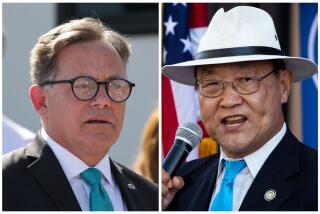Andy Stern’s reach
- Share via
Andy Stern has arguably been the most influential non-Californian in the affairs of California in the past 15 years. The organizing director of the Service Employees International Union from 1984 through 1996, and the SEIU’s president since then, Stern has shaped the state’s politics and much of its economy.
During Stern’s tenure atop the SEIU, the union doubled in size to roughly 2 million members, and in California it grew to nearly 700,000 members, far more than any other union in the state’s history. Stern, who stunned the liberal and labor worlds by announcing his resignation last week, turned the SEIU into the nation’s single biggest and most influential liberal political player. The union turned out the most precinct walkers, spent the most money and financed organizations that mobilized new immigrant voters and turned out the vote in key swing states.
California today is by no means a swing state, but that’s partly the result of the SEIU’s creation of and investment in groups that registered Latino immigrants and got them to the polls. Working alongside the Los Angeles County Federation of Labor, the SEIU became a force in the immigrant community. Just as Walter Reuther’s United Auto Workers funded and helped organize many key civil rights marches and lobbying campaigns in the 1960s, Stern’s SEIU helped fund and organize many of the immigrant rights campaigns of recent years, both nationally and locally. While changing demographics guaranteed that Los Angeles would eventually have substantial Latino political representation, there was no guarantee that labor would foster this rise, or that the resulting labor-Latino alliance would become a political powerhouse. For that, the SEIU and the County Federation deserve most of the credit.
During the Stern years, the SEIU also wielded its political clout to help organize several hundred thousand low-wage California workers. Union members worked hard to elect labor-friendly legislators who would remember them once in office. As a result, when homecare workers unionized, they found themselves bargaining with agencies created by officials they had helped elect. The SEIU’s raucous janitors were successful in part because they could count on the backing of elected officials and community activists as they demonstrated for better pay. It is a lasting mark of the union’s success that the janitors won the kind of family health insurance that is utterly beyond the reach of their nonunion counterparts in similar jobs.
At the same time, however, some of Stern’s decisions undermined the union’s successes. His appointment of Tyrone Freeman to head L.A.’s homecare union proved a disaster, with Freeman resigning amid financial scandal. More fundamentally, Stern’s 2005 decision to take the SEIU out of the AFL-CIO imperiled labor’s unified electoral operations up and down the state, and it’s been a continual challenge to state labor leaders to keep those campaigns from fracturing. His decision to take control of the largest SEIU local in the state, a successful Bay Area healthcare worker local, may have had a theoretical justification — Stern wanted to merge the local into a still-larger statewide local to bargain more effectively with employers — but has produced a predictably bitter conflict, diverting much of the SEIU’s staff and treasury into a protracted battle with the former local leaders over the right to represent their onetime members. And Stern’s jurisdictional dispute with UNITE HERE, after a wing of that union seceded and joined the SEIU, has pitted labor’s two most effective representatives of immigrant workers against each other. In a movement where solidarity is a day-to-day necessity, Stern has busted up almost as many things as he has built.
The SEIU’s California members include hundreds of thousands of state and local government employees. While they chiefly hold middle-income jobs, they enjoy benefits — defined-benefit pensions, for one — that have become increasingly scarce in the largely de-unionized private sector. Some blame the SEIU and other public sector unions for the fiscal crisis confronting California governments, and it’s true that the state is struggling under a tremendous pension burden. But it’s also possible that if other unions had been as successful as Stern’s (and if Stern’s union had been more successful) in organizing private sector workers, incomes would be higher, tax revenues would be greater and the state’s budgetary woes would be less glaring.
In the broadest sense, Stern’s legacy in California is to have hastened a positive political transformation — the growth of labor and Latino power in government — while retarding a grim economic one, the evisceration of the middle class by the forces of globalization and de-unionization. In organizing janitorial and homecare workers, Stern’s union kept a sizable number of workers from joining the race to the bottom that besets working-class America. His successors will need all of Stern’s smarts, and less of his divisiveness, if they are to have a shot at rebuilding America’s middle class.
Harold Meyerson is editor at large of the American Prospect and an op-ed columnist for the Washington Post.
More to Read
Get the L.A. Times Politics newsletter
Deeply reported insights into legislation, politics and policy from Sacramento, Washington and beyond. In your inbox twice per week.
You may occasionally receive promotional content from the Los Angeles Times.










